Tom's Hardware Verdict
The RT-AX57 Go isn’t the fastest router around, but it’s a versatile tool for mobile warriors.
Pros
- +
Relatively affordable at $139
- +
Multiple operating modes, including AiMesh support
- +
Support for 4G/5G smartphone tethering
Cons
- -
Performance is merely adequate
- -
Only one LAN port
Why you can trust Tom's Hardware
The routers that we typically test for Tom’s Hardware are large devices that can take up a lot of real estate and are designed to provide the absolute best networking performance for wired and wireless clients. However, the Asus RT-AX57 Go bucks that trend: it's a diminutive router that measures just under 5 inches x 5 inches and is less than an inch tall while weighing less than a half a pound. In other words, this router can easily slip into a laptop bag when traveling, which is something we can’t say for the best Wi-Fi routers.
Despite its small stature, the RT-AX57 Go provides good Wi-Fi 6 performance and is an ideal companion for distributing a network connection while on the go. With a street price of around $130, it won’t break the bank for hardcore mobile warriors.
Design of the Asus RT-AX57 Go
Unlike the towering mesh routers or eight-legged gaming routers that we review, the Asus RT-AX57 Go is a tiny little device. It’s roughly the size of two packs of playing cards laid side-by-side (4.72 x 4.72 x 0.85 inches). The entire unit is constructed of white plastic, while the bottom features ventilation slots to keep the unit cool. Although you can lay the RT-AX57 Go flat, Asus includes a small plastic stand that allows you to stand the 0.46-pound router upright.
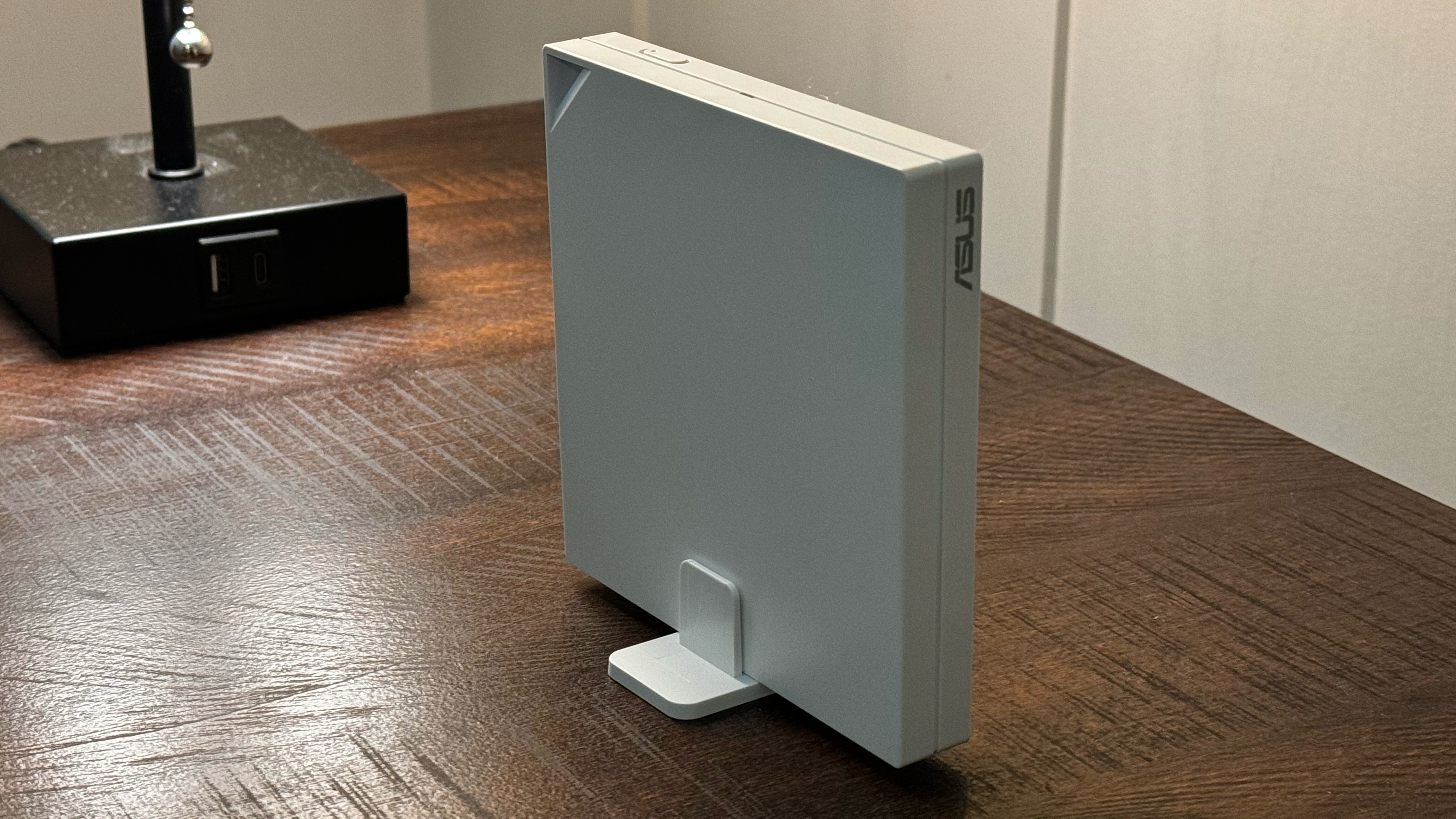
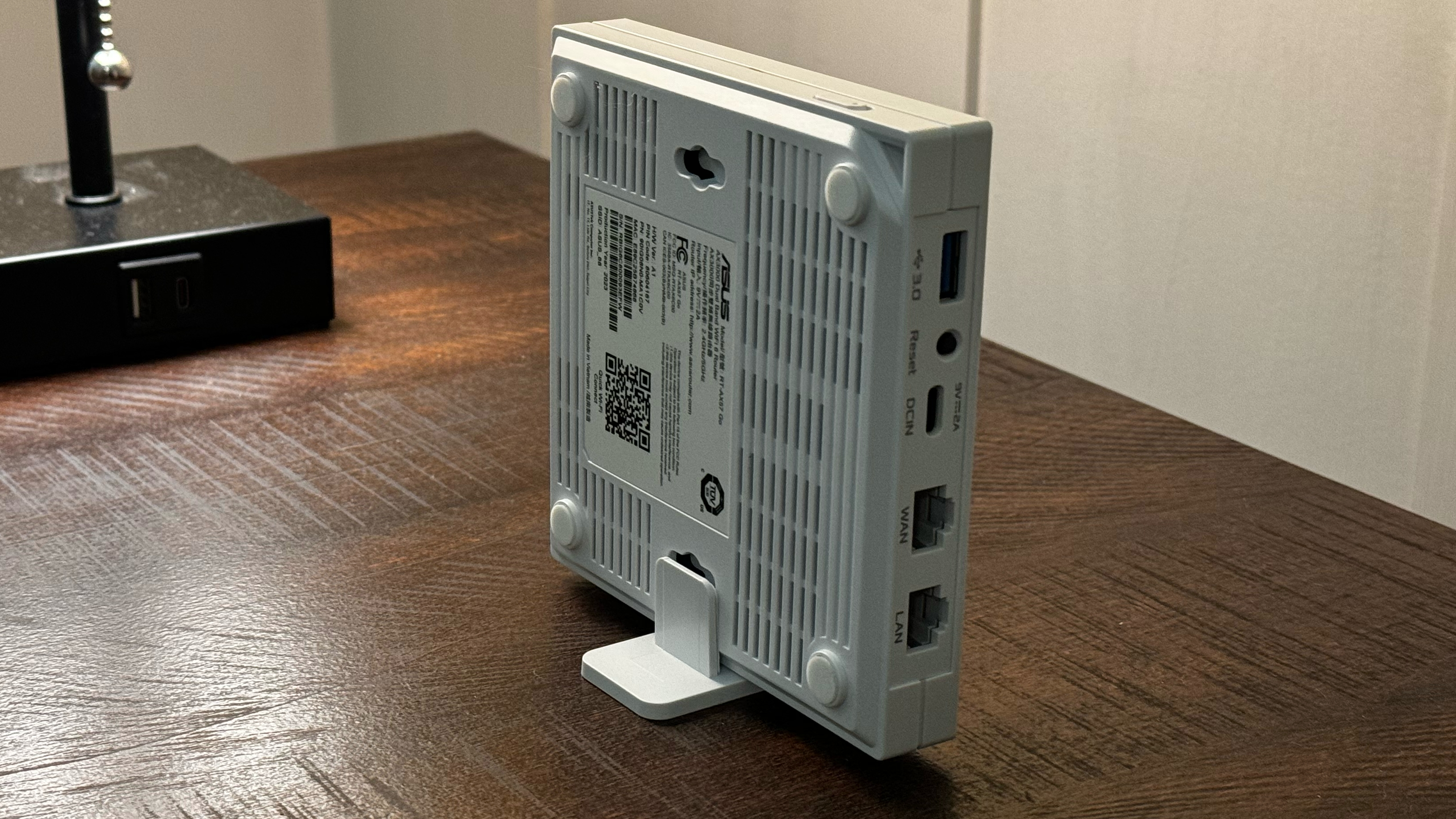
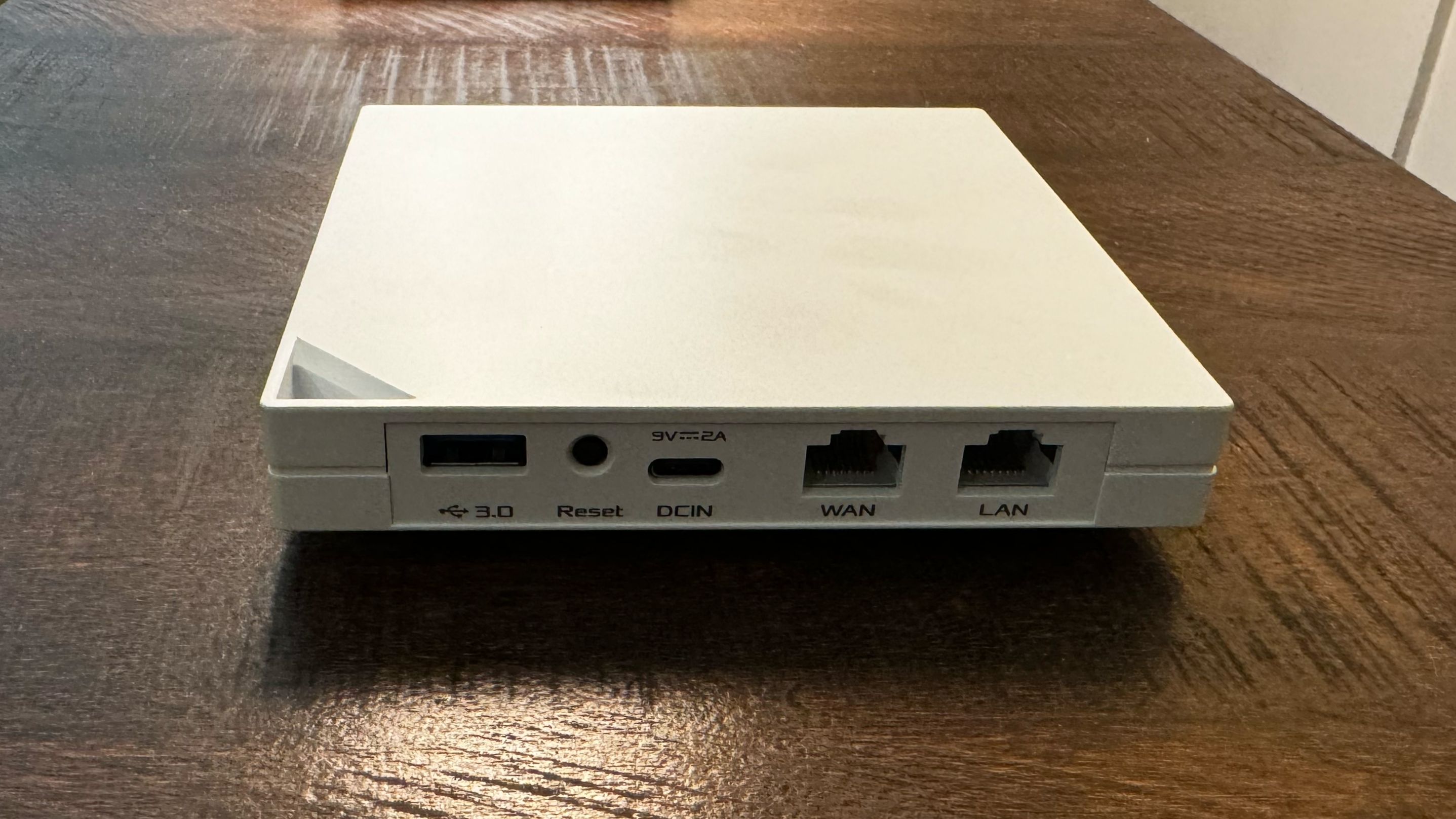
A white switch is next to the single LED on the side of the router. At first, I thought it was to turn the device on and off. However, after reading the quick start guide (hey, who reads manuals these days?), I discovered that the switch is programmable to perform customizable quick actions. These actions can be configured in the web interface.
The RT-AX57 Go obtains power from an included USB-C power adapter (18 watts). The power input is located on the back of the router along with a 1 gigabit WAN, 1 gigabit LAN, and a USB 3.2 Gen 1 USB-A port. A small 3-foot flat patch cable is included in the box.
Asus says the RT-AX57 Go is designed for use while traveling, hence its easily transportable size. However, it also has provisions on the bottom to wall mount the router if you wish to place it in a more permanent position.
| Wi-Fi Standard | Wi-Fi 6 |
| Wi-Fi Bands | WiFi 6 (802.11ax) (2.4GHz) : up to 574 Mbps |
| Row 2 - Cell 0 | WiFi 6 (802.11ax) (5GHz) : up to 2402 Mbps |
| Speed | 2.9 Gbps (2402 Mbps+ 574 Mbps) |
| Wi-Fi Coverage | square feet |
| CPU | Dual-Core 1.3 GHz |
| Memory | 128MB Flash, 512MB RAM |
| Ports | 1GbE WAN x 1, 1GbE LAN x 1, USB-C Power Port, USB 3.2 Gen 1x1 |
| Dimensions | 4.72 x 4.72 x 0.85 inches (W x D x H) |
| Weight | 0.46 pounds |
Setting up the Asus RT-AX57 Go
Asus knows routers, and setting up the RT-AX57 Go is very easy. I simply pointed my web browser to Asusrouter.com, after which the setup program asked me if I wanted to set up a new router. I configured it to obtain an IP address automatically and was asked if I wanted to combine the 2.4 GHz and 5 GHz bands into a single SSID or separate them. I named the 2.4 GHz band "ASUS_Pocket" while the 5 GHz band was named "ASUS_Pocket_5G."
Get Tom's Hardware's best news and in-depth reviews, straight to your inbox.
The setup program then forces you (for good reason) to change the admin login and password. Finally, it detected that new firmware was available and downloaded it for me. In total, it took about three minutes from the time I plugged in the router until it was fully set up and ready for action.
You can also set up the RT-AX57 Go using the Asus Router app for iOS or Android. I used the iOS version with an iPhone 15 Pro Max and the Android version with an Asus ZenFone 10 without issue.
Asus RT-AX57 Go Software
Given that the RT-AX57 Go is designed as a travel router, it has plenty of software features to leverage the capabilities. For example, you can plug the router into a network jack in a hotel room to create your own personal Wi-Fi hotspot. Like other Asus routers, you can leverage your phone's cellular internet connectivity with the RT-AX57 Go using the rear USB 3.2 Gen Type-A port.
This feature is particularly useful if your wireless carrier imposes limitations on hotspot functionality. For example, I use Visible's basic unlimited plan, which only allows one device to connect to your phone's hotspot. However, the RT-AX57 Go allows you to get around this limitation and support up to 70 devices.
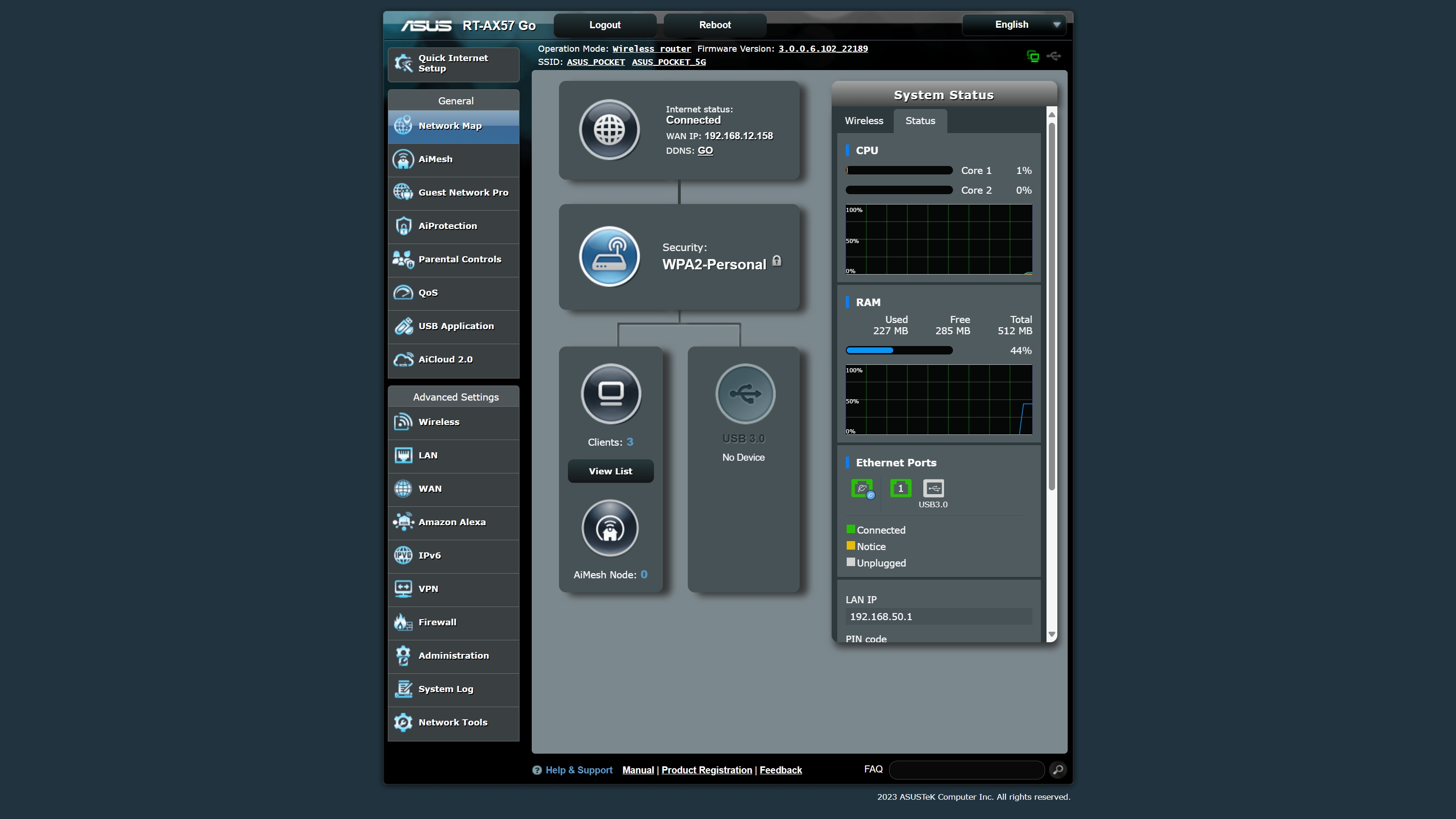

There are also several operating modes for the router, including the standard wireless router and access point modes. It also supports repeater, media bridge, and Public Wi-Fi (WISP) modes. In addition, the RT-AX57 Go supports AiMesh, which allows you to form a mesh network with other supported routers. For example, if you generally have good wireless coverage in your house except for one pesky dead zone, you can extend your network with an AiMesh device. You could use an Asus RT-BE96U as your primary router and add an RT-AX57 Go in your basement dungeon with spotty reception.
The aforementioned slider button on the side of the router can be programmed to enable the VPN, turn off the LED, or disable Wi-Fi. You can even turn off the button altogether if you wish.
Asus RT-AX57 Go Performance
The RT-AX57 Go is optimized for size and power efficiency, so it doesn’t come with a beefy power supply or massive antennas to ensure maximum performance. In fact, the RT-AX57 Go doesn’t have any external antennas, keeping its antennas internal. As a result, we need to keep performance expectations in check.
The usual caveats surrounding router testing still apply here. Your results will most certainly vary and are dependent on where you place the router, the construction of the home/office/hotel where the router will operate, and any radio interference that could affect router performance.
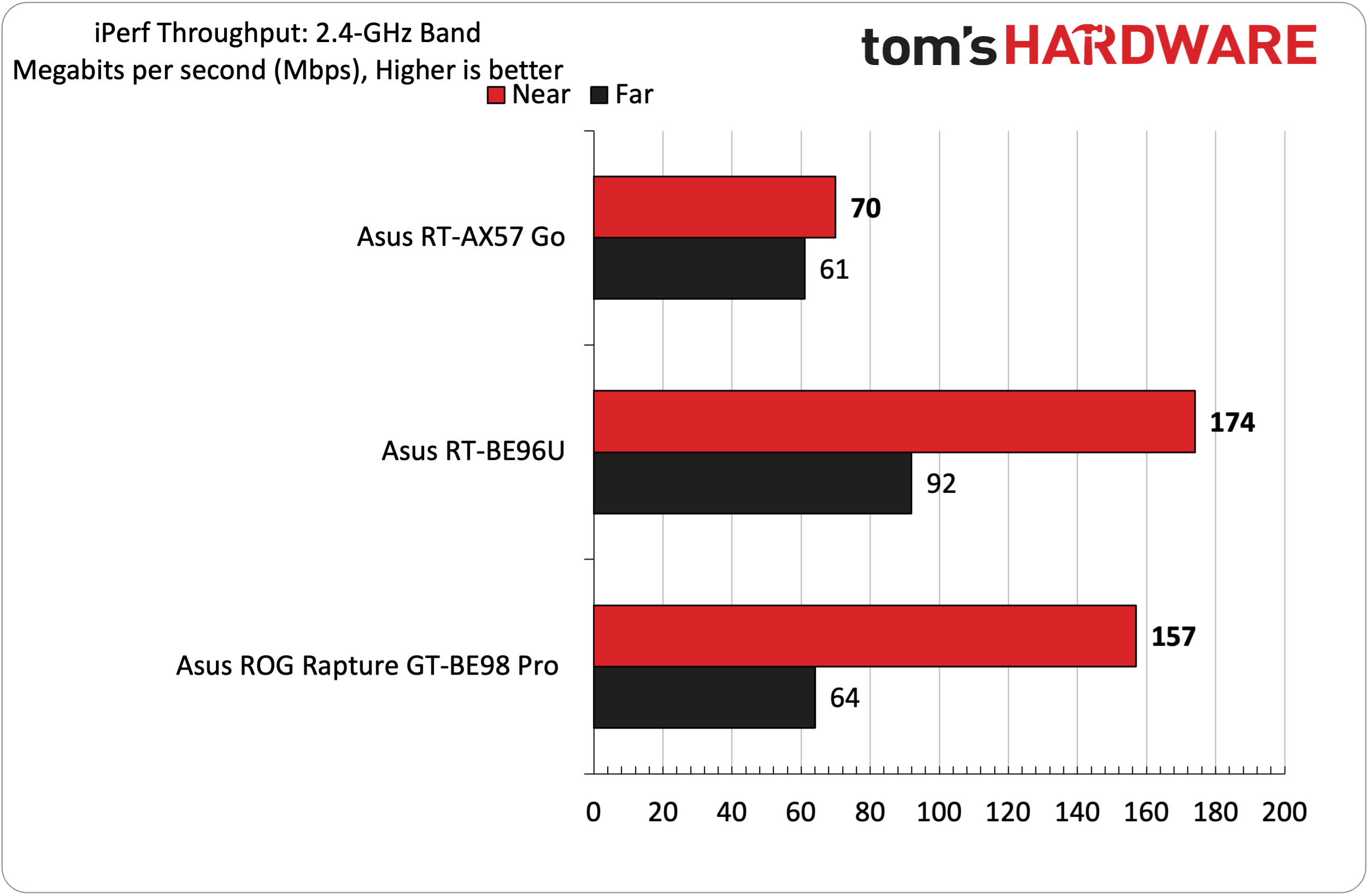

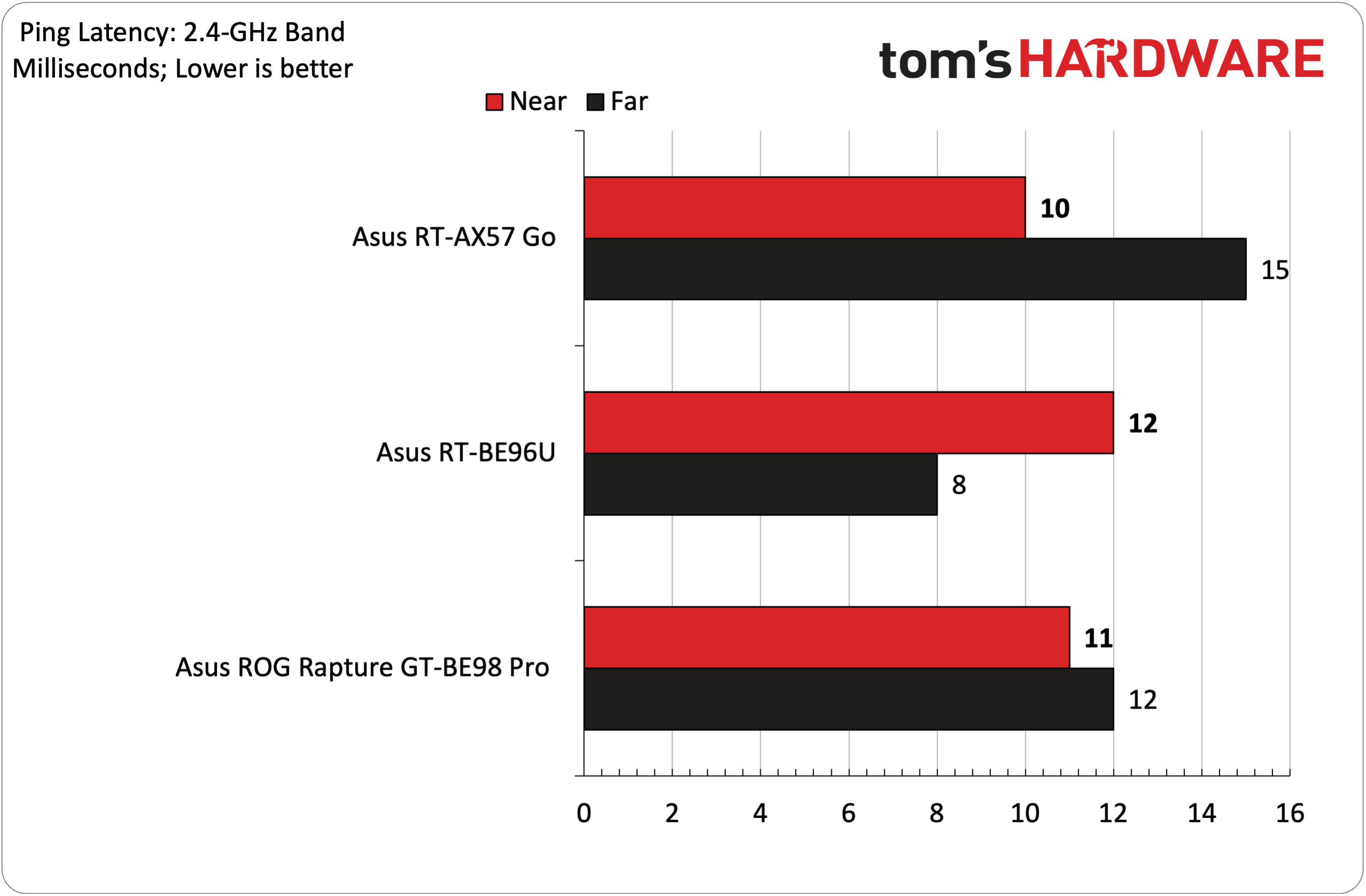


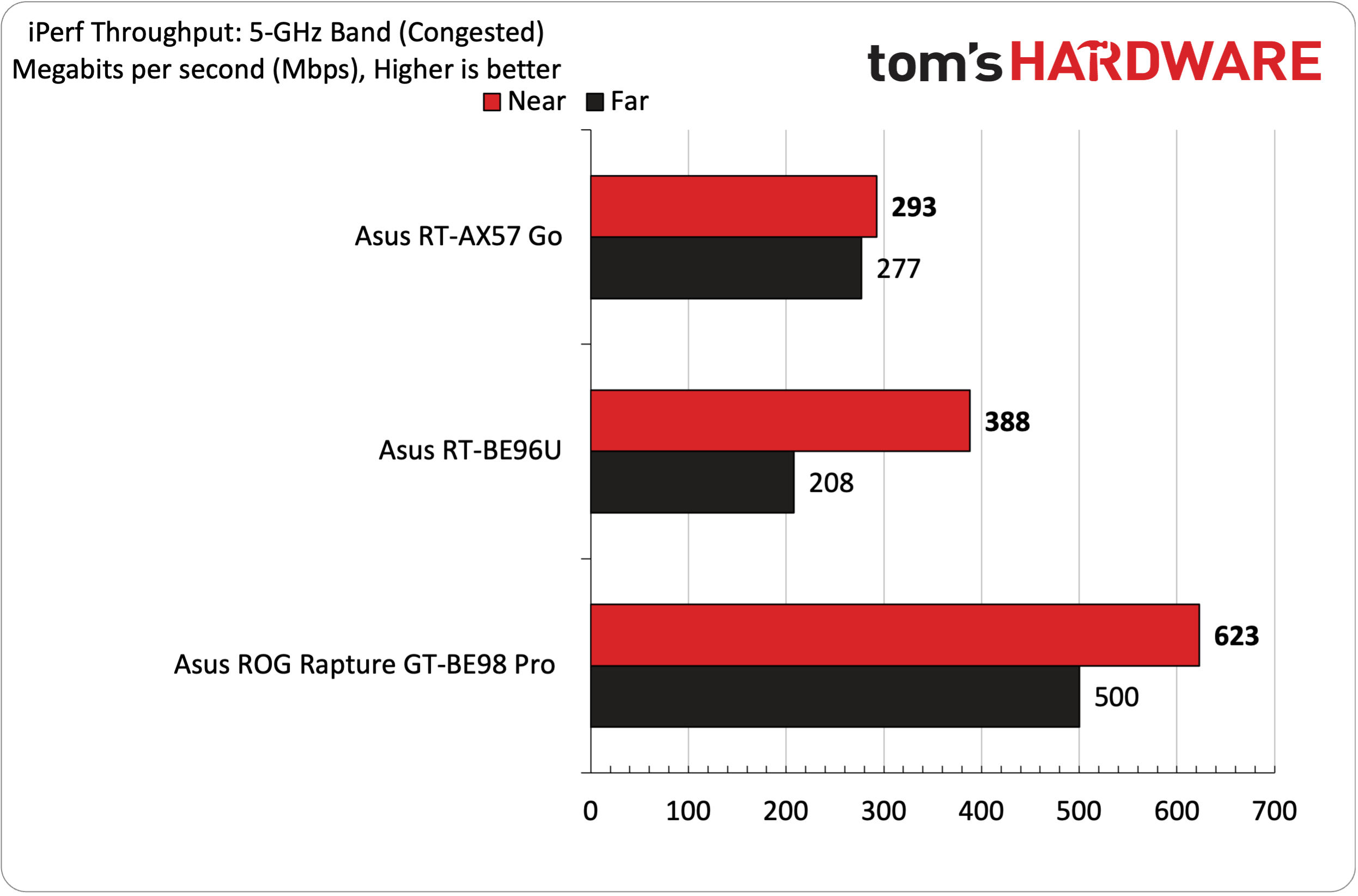

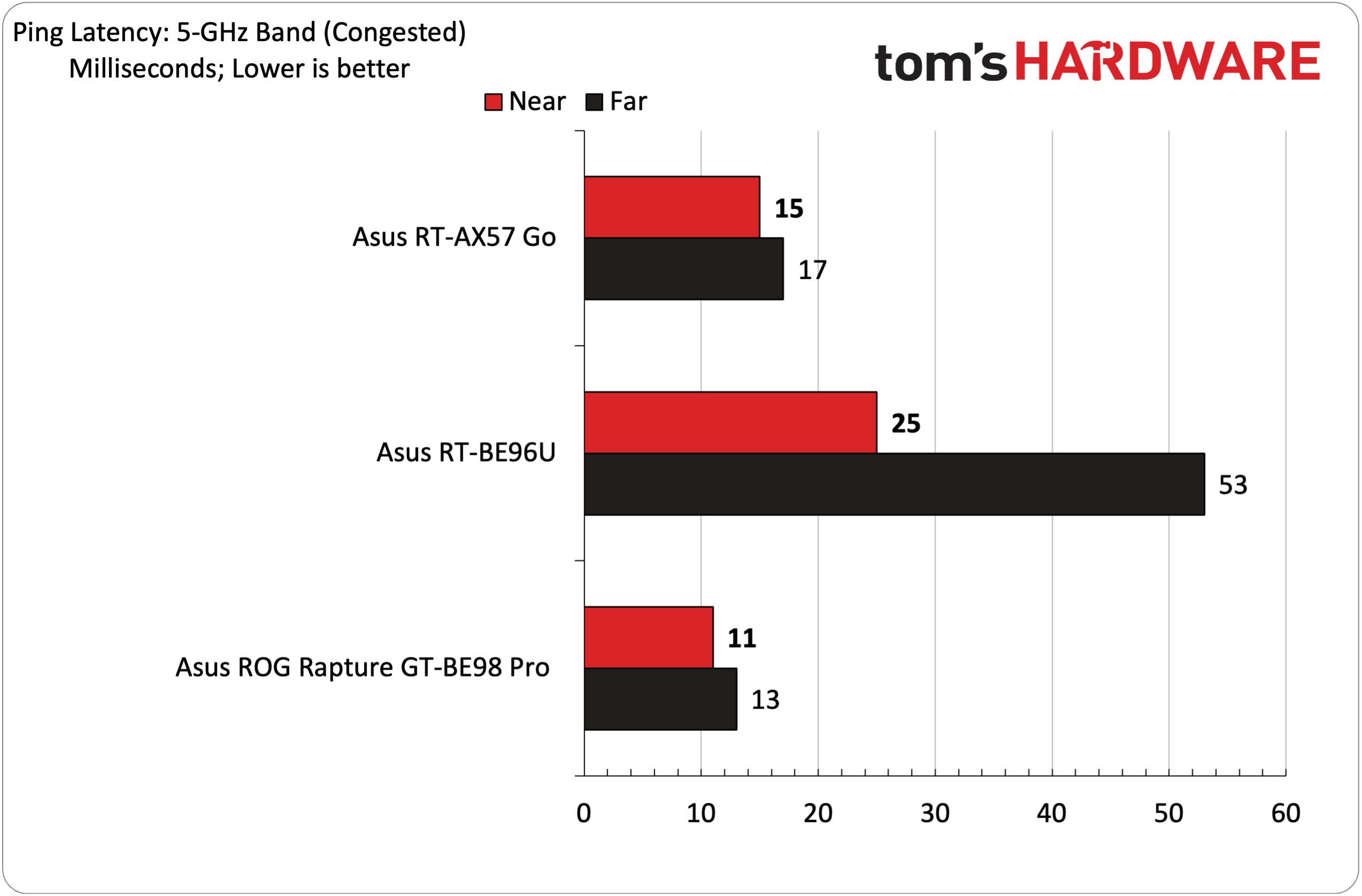
Router testing is performed in my home office with a client laptop at distances of six feet and 25 feet under uncongested and congested network conditions. During uncongested testing, a Wi-Fi 7 client is the only device on the network (wired or wireless). Wireless traffic is flooded with six 4K YouTube streams from six wireless clients during congested testing, while a seventh client is downloading 63 gigabytes of game files.
I perform Wi-Fi throughput testing with iPerf 3.16 and ping tests using Windows 11’s built-in tool. There's a CyberPowerPC desktop with a 10 GbE network adapter as a server connected to the 10 GbE LAN port on the RT-BE96U. An Acer Swift Edge 16 laptop is used for all the tests, which has a Qualcomm FastConnect 7800 Wi-Fi 7 wireless adapter. Both PCs run the latest versions of Windows 11 (Insider Preview Build) and have all the latest network drivers installed.
The Asus ROG Rapture GT-BE98 Pro and RT-BE96U Wi-Fi 7 routers are strictly included for speed comparisons.
In our iPerf test, the RT-AX57 Go maxed out at nearly 600 Mbps at six feet and hit 361 Mbps at 25 feet. While those are respectable numbers, they're no match for the pricier Wi-Fi 7-capable ROG Rapture GT-BE98 Pro and RT-BE96U. With congested traffic, the six-foot performance fell to 293 Mbps. Interestingly, there wasn’t much further degradation when moving out to 25 feet (277 Mbps).
When switching from the 5 GHz to the 2.4 GHz band, performance took a big hit. The RT-AX57 Go didn’t even break 100 Mbps, instead hitting 70 Mbps at six feet and 61 Mbps at 25 feet without any additional traffic. Loaded up with seven wireless clients, iPerf throughput barely nudged lower to 65 Mbps at six feet and remained the same at 61 Mbps at 25 feet.
Ping times measured between 10 ms to 18 ms in all of our testing.
Bottom Line
The Asus RT-AX57 Go is by no means the fastest router that we’ve ever tested. It doesn’t support the fastest wireless standard, Wi-Fi 7, or even its predecessor, Wi-Fi 6E. However, it does provide consistent wireless performance at close range, which fits its modus operandi.
The RT-AX57 Go will likely be used in a hotel room or to extend an existing wireless network using AiMesh. For those tasks, the router is a perfect fit. In addition, it supports smartphone tethering, which can provide wireless access to all your devices in a pinch. Given the router's low-power nature, a USB-C power bank used in conjunction with your smartphone could serve as a makeshift networking nerve center while camping.
With a street price of around $130, the RT-AX57 Go is reasonably priced for the subset of customers who can use this highly specialized router. If you're still running Wi-Fi 6 devices and need a replacement or upgrade, it will also perform well.

Brandon Hill is a senior editor at Tom's Hardware. He has written about PC and Mac tech since the late 1990s with bylines at AnandTech, DailyTech, and Hot Hardware. When he is not consuming copious amounts of tech news, he can be found enjoying the NC mountains or the beach with his wife and two sons.
-
brandonjclark Husband: waiting in car, impatiently...Reply
Wife: Running around house, frantically searching for something...
Husband: "Jane, hurry up! We've got to make this train!"
Wife: "Well, if you would put that thing in Park and come help me find the TRAVEL ROUTER we could get out of here!"
Coming to an ad, soon...
;) -
NedSmelly Thanks for this review. I would have liked to hear how it went with phone hotspotting though, particularly compatibility with iOS and various versions of Android (both direct USB tether and WISP). The only time you mention the phones is regarding app setup.Reply
